Pre-Production/Concept Art and Production Photos
This page may take some time to load given the number and size of the images. The descriptions and photos for this page are taken from the Cinefantastique and American Cinematographer issues dedicated to the film.
This page will grow in size when I scan the next set of photos in.
Pre-Production/Concept Art by Robert T. McCall
This following painting by Art Director Robert T. McCall is of an early version of Vincent which called for hinged legs to allow the robot to walk.
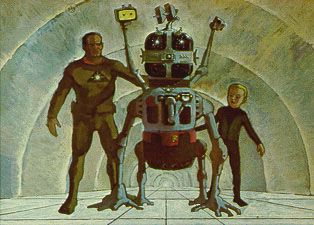
Here's McCall's final design concept for Vincent. Said McCall: "I thought of him as a hummingbird, as being able to levitate and dart around very gracefully."

The following is the early concept for the Palomino, which is radically different from Ellenshaw's final design.
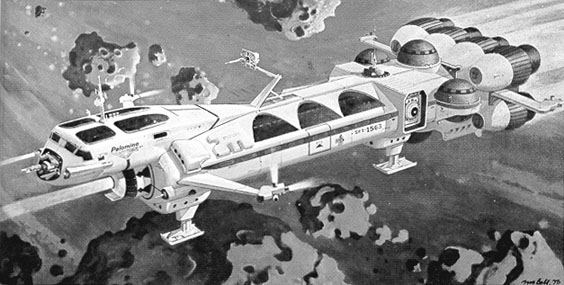
McCall's concept of the Cygnus command tower observatory.

McCall's design for the Cygnus - a NASA like, slab-sided ship. Ellenshaw kept the basic design, but transformed the ship's skin into a translucent steel lattice. For the most part, McCall's early design concepts were discarded when Ellenshaw signed on as the film's production designer in the summer of 1976.

Pre-Production/Concept Art by Peter Ellenshaw
This painting by Production Designer Peter Ellenshaw shows an early concept of the Palomino leaving its Earth base. The scene was later scrapped.

Production Photos
This is a behind-the-scenes shot of the set used to film the deleted detour through engineering sequence that was a part of the larger escape sequence. On the scaffold Director Gary Nelson and Director of Photography Frank Phillips can be seen lining up a shot of the Palomino crew. During filming, most of the sketchy set is hidden by steam.

On the left Director Gary Nelson can be seen applying one of Vincent's original "eyes." A magnified view of the eye is on the right. As robot designer George McGinnis explained: "With Vincent they wanted a robot whose eyes could be animated. So the eyes I came up with used a matrix of Ferrani-Packard discs, discs that flipped. You see them in these alpha-numeric readouts. They're small little discs that quiver when they flip. You could have created any pattern that you wanted with those eyes. But they had technical problems getting them animated when the principle actors were on the stage, and they didn't have the time to develop a solution to the problem. So they threw a couple of buttons on there, which bothered a lot of us. ... I wish the matrix of dots had worked initially, but I understand. ... They had the actors on stage. They had to do something."
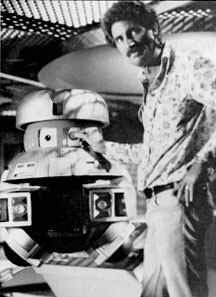

In this photo we see Pizer (Joseph Bottoms) firing his laser gun. If you look carefully (it didn't come out very well in the scan) you can see a trail of light that eminated from the weapon. According to the director of cel animation for the film, "...originally the ray guns had little lights installed in them so that everytime they pulled the trigger the light would go on, which was a good idea before they started the film. But those people were just pulling those triggers all over the place. It would have wound up like Star Wars, where you were locked into having to animate a laser beam everytime someone pulled a trigger. You'd have had them shooting into the ceiling, into the floor, all over the place. They were even shooting each other in the back of the head! [laughs] So the lights went."
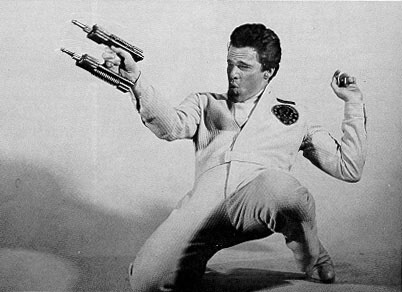
Here two assistants help screw head mime Tommy McLoughlin into the fiberglass costume of sharpshooter Captain Star. His mouth and chin are blackened just in case the lights on the set hit the mouthpiece of the costume - if they would have hit very brightly you would be able to see the face behind it without the makeup.
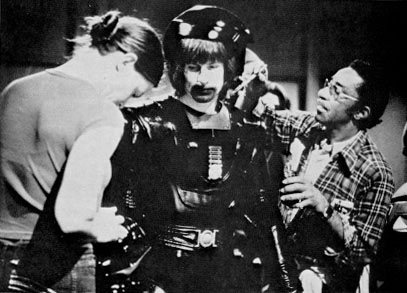
A behind-the-scenes shot of the Probe Ship set, which sat atop a hydraulic gimble that allowed it to rock back and forth. In the film it can be seen when the remainder of the Palomino crew climbs up into the probe ship to escape from the Cygnus.
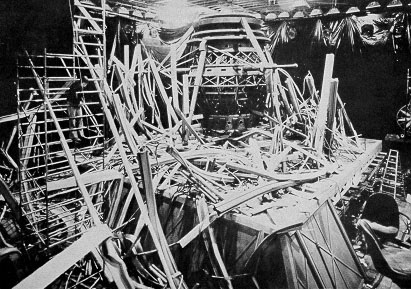
Filming the tumbling of the black hole passage with the Rolling Probe set, which spun around the actors like "the old barrel-roll ride you used to find at amusement parks."
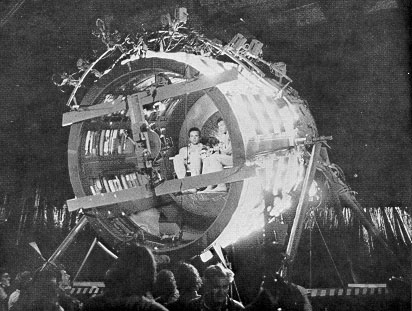
Pictured here is Harrison Ellenshaw hard at work on the matte painting for the Palomino Power Trench, with the matte scan camera lined up for filming behind him.
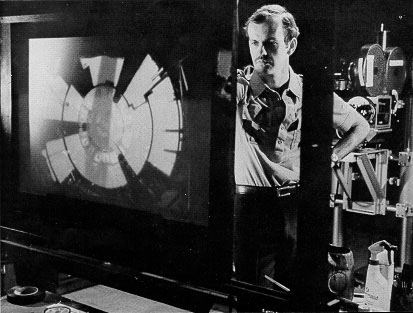
All images Copyright © The Walt Disney Corporation.
This page is exclusively maintained by Denis Warburton.













